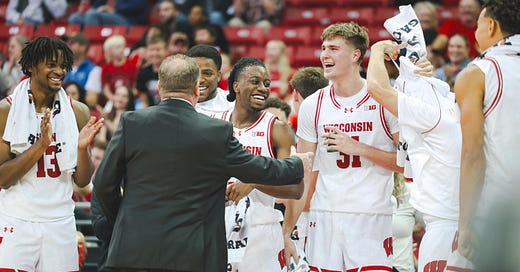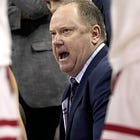Retaining John Blackwell, Nolan Winter a 'top priority' for Wisconsin basketball
Wisconsin basketball has shifted to a one-year roster building model, with the staff's 'top priority' being to retain John Blackwell and Nolan Winter.
For decades, Wisconsin basketball thrived on stability—recruiting players who fit their system, developing them over multiple seasons, and building rosters with long-term continuity in mind.
That era is over.
The rise of NIL and the transfer portal has forced every college program to approach roster-building differently, and Wisconsin is no exception.
The days of mapping out multi-year development plans for recruits you spent years pursuing have been replaced with an annual roster reset, where keeping your best players is viewed as being just as important as adding new talent.
As Trilly Donovan often says on X, sometimes the best portal additions are the ones you don't have to make.
Head coach Greg Gard is well aware of this reality. Even with Wisconsin outperforming expectations and being in the thick of the Big Ten title race, the staff must also keep one eye on the future.
“In this era that we're in—and we're not going backward—the acclimation with rosters and a lot of new faces that are at different places—it’s a transient world in terms of how our rosters come together," Gard said on The Swing.
"We've evolved and tried to stay on the cutting edge, not only in things on the court with what we're doing offensively but even off the court. A lot of that plays into the rosters assembly and knowing it'll be an annual reset."
Their top priority on Wisconsin's 2025-26 offseason to-do list is retaining sophomore standouts John Blackwell and Nolan Winter—two foundational pieces who have played significant roles this year.
“Retaining Blackwell and Winter is our top priority, along with some other guys,” Gard said. “And then you build from there.”
Both members of the Badgers 2023 recruiting class have taken major strides in their second seasons with the program.
Blackwell has blossomed into a key offensive contributor, showcasing his ability to take on the primary ball-handling role this season while providing reliable scoring and playmaking.
Blackwell is putting up 15.3 points, 4.7 rebounds, and 2.2 assists per game while shooting 46.7% from the field. According to Barttorvik, Blackwell's PRPG has jumped from 2.3 as a freshman to 3.2 in year two, the third-best mark on the team.
Winter, meanwhile, has given Wisconsin a true stretch-four presence, combining his impressive size (7-foot) and shooting ability in a way that perfectly complements the Badgers’ evolving offensive system. Winter has made a massive leap in his development, going from a lightly used freshman who looked like a baby deer at times into a weapon.
The Minnesota native is now averaging 10 points, 5.7 rebounds, and 1.1 assists while shooting 39% from beyond the arc. His PRPG has also seen a meteoric rise, jumping from 0.6 last season to 3.7 as a sophomore—the second-highest on the team, trailing only John Tonje.
It’s clear why Wisconsin’s coaching staff sees Blackwell and Winter as cornerstone pieces for the future. This season’s success has been built on retaining their veterans like Steven Crowl, Max Klesmit, Kamari McGee, and Carter Gilmore—players who have provided stability while internal development and the right portal additions have elevated the roster.
But in today’s college basketball landscape, retaining top talent is far from guaranteed.
“You have a good player, and they're going to be poached on,” Gard admitted. “It’s just such a dog-eat-dog [world], and it's hard to build a program. You're in roster management, not program building.”
This shift has changed how Gard and his staff approach team construction.
Instead of evaluating long-term fit and projecting development over multiple seasons while planning to have successors in place, roster management has become a year-to-year exercise.
Every offseason, they must assess what the team needs are, have honest conversations, identify potential departures, and position themselves to be competitive in retaining core players.
“We used to do it in three- or four-year snapshots, moving players through as freshmen, sophomores, juniors,” Gard explained.
“Now, you’re looking at one-year snapshots—what does next year's team need to be? What are we going to need to add? Where are our weaknesses, where are our strengths?”
That reality has forced Wisconsin to be more aggressive in retaining its best players, continually monitoring outside interests, and making sure its NIL infrastructure remains competitive.
The good news for Wisconsin is that they may soon be better equipped to retain players. If the House vs. NCAA settlement is approved this spring, schools will be allowed to share up to $20.5 million in revenue with athletes, and men’s basketball will receive a portion of that to distribute across its roster. That additional financial support—combined with the work this staff has already done behind the scenes to build a NIL budget—could help them compete in keeping players like Blackwell and Winter.
There are also basketball reasons for them to stay. Wisconsin’s offensive system fits both players well, and they have clear evidence that they've improved while playing for this coaching staff. For players weighing their future options, that combination of development, system fit, and financial security could make a strong case for staying in Madison.
But make no mistake—this is the reality of modern college basketball.
Even in a program built on consistency, the offseason is now filled with uncertainty. Wisconsin must not only recruit high school talent and portal players but also re-recruit its own roster every single year.
Last offseason served as a harsh reminder of that reality. Second-team All-Big Ten guard AJ Storr left for a bigger payday at Kansas, and based on his struggles this season, it’s clear he made the right call. The transfer portal is unpredictable, and players have to capitalize on their free market value while they can—you never know when your stock will peak before crashing back down.
But the tougher blow, both for the team and the fanbase, came when starting point guard Chucky Hepburn took an opportunity at Louisville that nobody—not even coach Gard could fault him for taking.
"I'm not mad at anybody because, specifically Chucky and AJ, if anybody in their right mind told any of you guys or gals that you could go triple your income by taking a different job, you'd do it in a heartbeat, no questions asked," said Gard.
"I would probably tell my kid to do the same thing if I was in that position, because the earning power window was really small. And when they have those types of opportunities in front of them, that's hard to say no to. So I don't begrudge them at all for that."
As Gard put it, “everybody’s in a one-year window.”
“We are well aware and watching and keeping tabs on the whole world. I would say we’re trying to turn over every rock and look everywhere.”
Wisconsin isn’t just competing to land complimentary talent—they’re constantly fighting to keep their best players from being lured away.
Blackwell and Winter have become fan favorites, and their continued growth has been one of the most promising storylines of the season. If Wisconsin can retain them, it would be a massive win—not just for next year’s roster but for the long-term outlook of the program.
The Badgers' coaching staff has been proactive in conversations with Blackwell and Winter, working to ensure they remain at Wisconsin.
“Those talks have been going on for quite a while,” Gard noted.
For Wisconsin, competing in the modern college basketball landscape is no longer just about X’s and O’s. It’s about managing the roster in a way that ensures stability without losing ground to programs with deeper NIL pockets.
“I think you operate in a one-year window and you try to you put together the the very best team you can given the the resources and and position you're in."
Until guardrails and legislation exist, Wisconsin’s path forward is clear: keep top players like Blackwell and Winter, embrace the reality of annual roster turnover, and continue to evolve.
One thing is certain—college basketball isn’t going back to what it once was. And neither is Wisconsin.
We appreciate you taking the time to read our work at BadgerNotes.com. Your support means the world to us and has helped us become a leading independent source for Wisconsin Badgers coverage.
You can also follow Site Publisher Dillon Graff at @DillonGraff on X.





